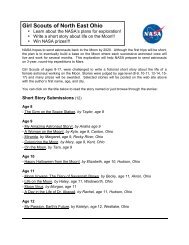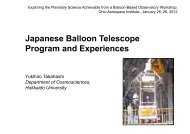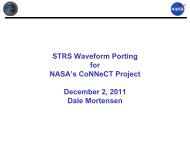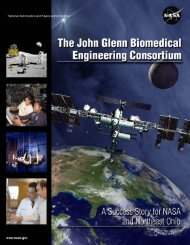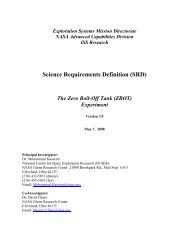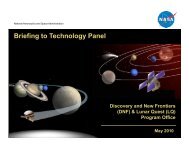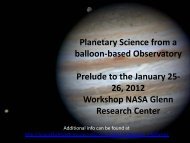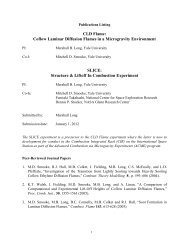Amusement Park Physics With a NASA Twist - Space Flight Systems ...
Amusement Park Physics With a NASA Twist - Space Flight Systems ...
Amusement Park Physics With a NASA Twist - Space Flight Systems ...
Create successful ePaper yourself
Turn your PDF publications into a flip-book with our unique Google optimized e-Paper software.
Newton’s Law of Universal Gravitation<br />
Any two objects have a force of attraction between them.<br />
Newton reasoned that the orbits of the planets were caused<br />
by the forces of attraction between the planets and the Sun,<br />
the gravitational force. The amount of gravitational pull<br />
depends on the mass of an object. The more massive the<br />
object, the stronger the pull. Earth is a huge mass with an<br />
enormous gravitational force, pulling everything toward its<br />
center. Because the gravitational pull one feels on Earth is<br />
so huge, one may not notice other pulls from smaller objects<br />
on Earth, which are negligible in comparison and are not<br />
strong enough to overcome friction.<br />
Earth’s mass creates a gravitational field that attracts objects<br />
with a force inversely proportional to the square of the distance<br />
between the center of the object and the center of Earth and is<br />
shown in the equation F G = Gm E m o /r 2 . F G is the gravitational<br />
force, G is the universal gravitational constant, m E is the mass<br />
of Earth, m o is the mass of the object, and r is the distance<br />
between the centers of Earth and the object. At the surface of<br />
Earth, the acceleration due to gravity is approximately<br />
9.8 meters/second 2 . This acceleration is called 1 g or 1 Earth<br />
gravity (“g” refers to the acceleration caused by the gravitational<br />
force F G ). Using the same giant ruler reference frame,<br />
1 g = –9.8 meters/second 2 . The sign is negative because the<br />
acceleration is inward toward the center of Earth, or downward.<br />
Newton's Law of<br />
Universal Gravitation<br />
All objects have a force of<br />
attraction among them that is<br />
proportional to the product of<br />
their masses and inversely<br />
proportional to the square of<br />
the distance between them.<br />
Massive bodies, such as planets, moons, and stars, exert<br />
different sizes of forces of gravity on an object, depending on<br />
the masses and the distances between the objects. The Moon,<br />
for instance, has one-fourth the radius of Earth, 1.2 percent of<br />
Earth’s mass, and has one-sixth as much gravity as Earth. The<br />
Sun could hypothetically hold 1 million Earths and has an<br />
immense gravitational pull. This explains why the planets in our<br />
solar system orbit the Sun.<br />
Remember that gravitational pull is a two way street. Just as<br />
Earth pulls on the Moon, the Moon pulls on Earth. The tides<br />
on Earth are caused by the gravitational pull of the Moon and<br />
the Sun. Even though the Sun is comparatively farther away<br />
than the Moon, it is much more massive. The effect on the<br />
tides of Earth is the greatest when the Moon and the Sun are<br />
on the same side of the Earth and in a straight line with<br />
respect to each other.<br />
19<br />
<strong>Amusement</strong> <strong>Park</strong> <strong>Physics</strong> <strong>With</strong> a <strong>NASA</strong> <strong>Twist</strong><br />
EG–2003–03–010–GRC



